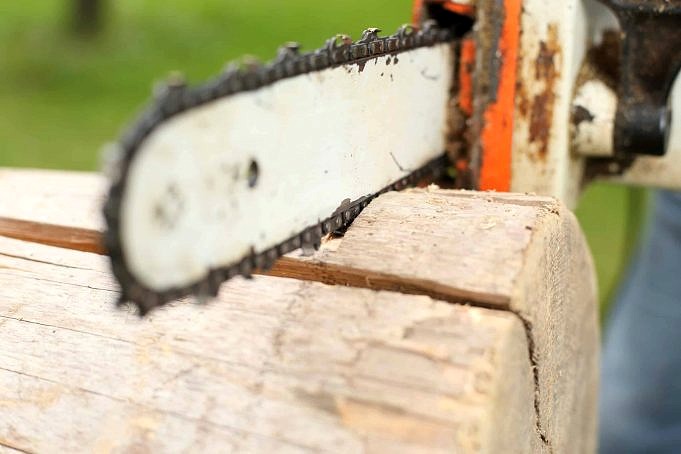There are many compression ratios available for chainsaws. However, most manufacturers recommend at least 10 to 1.
This means that the piston of the saw moves 10 times more air per stroke than if there was no compression.
More compression generally means less effort and faster cutting. But, excessive compression can cause damage to the motor and chain.
Too much compression can cause excessive heat and noise in a chainsaw, which will also reduce its lifespan.
How Do You Decide The Right Compression Level For Your Chainsaw’s Blade?
To ensure the chainsaw’s best performance and proper functioning, it should be checked on a regular basis. A chainsaw with a compression reading below 110 psi is considered to be in optimal condition.
To ensure the chainsaw’s best performance, its compression should be regularly checked. A chainsaw with a compression reading below 110 psi is considered to be in excellent condition.
What Compression Should A Poulan Chainsaw Have?
It is crucial to choose the right compression level for the Poulan chainsaw in order to maintain a good chain and ensure smooth operation.
Poulan recommends a chainsaw that has between 90 and 110 PSI of compression. Higher compression levels are more powerful and can last for longer. However, they can produce more heat and noise.
A chainsaw that has between 90 and 110 PSI of compression is best for most people.
What Compression Level Should A Husqvarna Chainsaw Have?
It all depends on how much pressure the saw is being used. Husqvarna chainsaws typically have a pressure range of 90 to 160 PSI, so it is important to choose the right compression level to suit your needs.
A lower compression setting (around 100 PSI) is best if you are using the saw for firewood cutting. This will reduce wear on your engine, transmission, and other components.
You should crank up the compression to 160 PSI if your saw is being used for large cuts or to tackle harder wood. This will ensure your chain doesn’t crack easily and stays in great condition.
It is important to know the compression level of your chainsaw if you want it to run smoothly and prevent costly repairs later.
What Compression Should A Small 2-stroke Engine Have?
Performance can be affected by compression in small engines. A 2-stroke engine should have a maximum pressure of 110-130 PSI.
Excessive compression can result in increased wear on parts, while lower compression can cause reduced power and poorer fuel economy.
It is crucial to find the right balance in order for your engine to run smoothly and deliver its best performance.
Can A Chainsaw Be Run With Low Compression?
A chainsaw with low compression can lead to problems like difficulty starting the engine, decreased sawing power and increased wear.
Try cranking your engine to the maximum speed for several seconds if your chainsaw is having difficulty starting. If your chainsaw is still not starting, you may need to have its compression checked by a mechanic.
It will be more difficult to start a low compression chain than a high compression one.
What Are The Signs Of A Low-compression Chainsaw?
Low compression could cause problems in your chainsaw. Low compression can cause engine overheating, which can lead to serious issues. These are the top seven signs that a chainsaw has low compression.
- When you pull the trigger, the saw blade will not start.
- The saw seems to be out-of-adjustment.
- You will find saw stalls often.
- The chain tensioner doesn’t seem to be working properly.
- When in use, the saw blades wobble excessively
- During use, you may hear a lot of noise from the chainsaw.
- The chainsaw is easy to start but stops shortly afterwards. This may occur several times in one cutting session.
How Do You Fix A Low Compression Chainsaw
Your chainsaw will not run well if it doesn’t have enough compression. This could lead to problems with your saw, bar, and chain. These are some ways to fix low-compression chainsaws.
- Make sure to check the oil level. Low oil will cause the engine to compress less and make the chainsaw run harder. If necessary, add more oil.
- Check that the chain is in good working order. Chainwear can cause the chainsaw to lose its compression. Make sure you check it frequently and have it sharpened as needed. Replace the broken or worn-out chain.
- If the spark plugs are old or worn, replace them. Wearing or dirty spark plugs can reduce the chainsaw’s compression, making it more difficult to start. As needed, replace many of them.
How Can I Tell If My 2 Strokes Have Low Compression?
Low compression can cause poor fuel economy, reduced performance, or even engine damage.
The fuel’s compressibility into the cylinders measures how tight the air-fuel has been packed. A lack of compression can make the engine less efficient and cause it to struggle to turn.
You can test and improve your compression in many ways.
Check the condition and wear of your spark plugs This will reduce compression.
Check the valves. Damaged or improperly sealing can cause compression to decrease.
Check for leaks Leakage and loss can be caused by bad gaskets, warped heads or defective valve springs.
What Could Cause A Chainsaw’s Compression To Be Too High?
Too much compression in a chainsaw can cause the chain to leap off the sprocket. This could eventually result in a loss of power or injury.
A chainsaw that is too compressed can be caused by a number of factors, such as worn or defective parts, improper blade setup and poor maintenance.
You should take your chainsaw to your dealer if you see excessive compression.
Final Thought
When using your chainsaw, it is important to know the compression ratio.
Keep your compression ratio in mind while carving logs and clearing brush to get great results.



